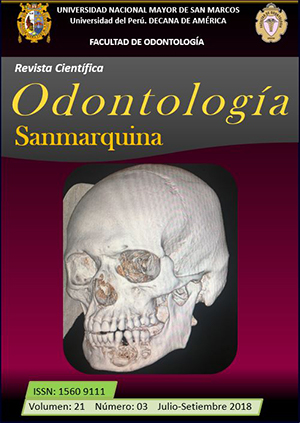Evaluation of micro strain in different thicknesses of the buccal bone plate
DOI:
https://doi.org/10.15381/os.v21i3.15150Keywords:
Cortical bone, Dental implants, Finite element analysisAbstract
For an implant-supported restoration of the maxillary anterior area; the buccal bone plate should have a minimum thickness to ensure an optimal and predictable behavior of soft tissue. Objective: To evaluate the mechanical behavior of stress and microstrain (von Mises yield criterion); in different thicknesses of buccal maxillary bone plates. Methods: The finite element method was used for modeling the maxillary anterior area with three different buccal bone thickness 0.5, 1 and 1.5 mm. An implant-supported restoration was modeled as well, to which a static load of 200 N was applied. Stress and microstrains were obtained in the buccal bone plates at 2, 4 and 6 mm from the alveolar crest towards the apical direction, both in cancellous and cortical bone. Results: Based on the finite element method, it was found that in the thickness of 0.5 mm of buccal bone plate (cortical) with 2 mms height, results showed stress von Mises (31 056 mpa) and displayed microstrains (2 154 µε). As the thickness increased to 1.5 mm with the 2 mm height results stated (22 913 mpa and 1 570 µε). This same trend was observed in the other two heights. Conclusions: The highest values von Mises and micro deformation were found on the crest of the buccal plate with 0.5 mm thickness and decreasing as the volume of cancellous bone increased towards apical direction.Downloads
Downloads
Published
Issue
Section
License
Copyright (c) 2018 Julio Cesar Escobar Restrepo, Juan David Serna Ceballos, Federico Latorre Correa, Junes Abdul Villarraga Ossa

This work is licensed under a Creative Commons Attribution-NonCommercial-ShareAlike 4.0 International License.
AUTHORS RETAIN THEIR RIGHTS:
a. Authors retain their trade mark rights and patent, and also on any process or procedure described in the article.
b. Authors retain their right to share, copy, distribute, perform and publicly communicate their article (eg, to place their article in an institutional repository or publish it in a book), with an acknowledgment of its initial publication in the Odontología Sanmarquina.
c. Authors retain theirs right to make a subsequent publication of their work, to use the article or any part thereof (eg a compilation of his papers, lecture notes, thesis, or a book), always indicating the source of publication (the originator of the work, journal, volume, number and date).






